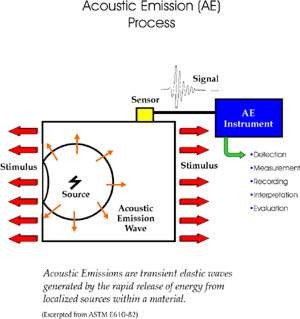ACOUSTIC EMISSION THEORY

Acoustic Emission, according to
ASTM, refers to the generation of transient elastic waves during
the rapid release of energy from localized sources within a
material. The source of these emissions in metals is closely
associated with the dislocation movement accompanying plastic
deformation and the initiation and extension of cracks in a
structure under stress. Other sources of Acoustic Emission are:
melting, phase transformation, thermal stresses, cool down
cracking and stress build up.
The Acoustic
Emission NDT technique is based on the detection and conversion of
these high frequency elastic waves to electrical signals. This is
accomplished by directly coupling piezoelectric transducers on the
surface of the structure under test and loading the structure.
Sensors are coupled to the structure by means of a fluid couplant
and are secured with tape, adhesive bonds or magnetic hold downs.
The output of each piezoelectric sensor (during structure loading)
is amplified through a low-noise preamplifier, filtered to remove
any extraneous noise and furthered processed by suitable
electronic equipment.
The
instrumentation of Acoustic Emission must provide some measure of
the total quantity of detected emission for correlation with time
and/or load.
Applications
-
Laboratory &
R&D studies
-
In field inspection
-
Structural integrity evaluation
-
Vessels testing [ambient, hot or cryogenic, metallic
and FRP, spheres]
-
Tank bottom testing
-
Nuclear components inspection (valves, lift beams,
steam lines)
-
Corrosion detection
-
Pipeline testing
-
Transformers testing (Partial Discharge)
-
Railroad tank car testing
-
Tube trailers & high pressure gas cylinders
-
Reactor & high energy piping testing
-
Aging aircraft evaluation
-
Advanced materials testing (composites, ceramics)
-
Production quality control
-
Rocket motor testing.
Acoustic Emission for Laboratory Testing
Acoustic Emission
inspection is a powerful aid to materials testing and the study of
deformation, fracture and corrosion. It gives an immediate
indication of the response and behavior of a material under
stress, intimately connected with strength, damage and failure.
Acoustic Emission is used also for monitoring chemical reactions
including corrosion process, liquid solid transformations, phase
transformations.
Acoustic Emission IN FIELD TESTING
Many codes and
standards exist for Acoustic Emission testing of vessels, from
transportation gas cylinders and railroad tanks to thousands tons
storage tanks. Because only active defects and deterioration
produce Acoustic Emission no time is wasted on inactive defects
which are not threatening structural integrity.
Global monitoring- 100% Inspection of the structure
A major advantage
of Acoustic Emission inspection is that does not require access to
the whole examination area. E.g. for covering a total area of a
16m-diameter sphere 30-40 sensors are needed. Thus, the cost of
the test is significantly less than inspection with conventional
NDT methods (for 100% inspection and scanning of the whole area).
Identified problem areas can be inspected using conventional NDT
methods.
Testing with insulation /high temperature processes
In cases of
insulation, only small holes in insulation are required for
sensors mounting, resulting in more cost savings. In cases of high
temperature processes, wave-guides are used to guide the Acoustic
Emission waves from the hot surface to the edge where the sensor
is mounted. Finally, in large cryogenic vessels, permanent sensors
are mounted under insulation for periodic inspection control.
On-line testing
As the method
records defects in real time, it offers the possibility of on-line
inspection, e.g. during hydrostatic testing. Other types of
on-line stress application are introducing of gas into the upper
vapor space, temperature control etc.
Rapid inspection
The actual
Acoustic Emission test takes a matter of hours, and, in some
cases, even less. There is no comparable technique which can
provide 100% volumetric inspection.
Cost Reduction
The use of
Acoustic Emission results in considerable reduction in plant
maintenance costs, while increasing the available information
about plant integrity. Plant downtime for inspection is also
minimized.
Permanent recording of test
Acoustic Emission
data are digitized and stored on a PC, providing permanent
recording of the test to be used at any time for re-evaluation and
post processing analysis.
Defect Location
When more that
one sensors are used, Acoustic Emission source can be located and,
thus, the defective area. Location is based on the wave
propagation principles within the materials and is effectuated by
measuring the signal's arrival time to each sensor. By comparing
the signal's arrival time at different sensors, the flaw’s
location can be defined through triangulation.
Linear location
is used on long gas cylinders, planar (2-dimensional) location for
thick walled and gas filled vessels, while 3-dimensional location
is used for power transformers and concrete structures.
ADVANTAGES
Compared to
conventional inspection methods the advantages of the Acoustic
Emission technique are:
-
High
sensitivity.
-
Early and rapid
detection of defects, flaws, cracks etc.
-
Real time
monitoring
-
Cost Reduction
-
Defective area
location: only critical defects provide sustainable Acoustic
Emission sources.
-
Minimization of
plant downtime for inspection, no need for scanning the whole
structural surface.
-
Minor
disturbance of insulation.
-
Application of Artificial Intelligence (AI) and Technological
Packages: Expert systems for evaluating the condition of
metallic pressure systems and tank bottoms based on the acquired
experience of a huge number of tests are world wide used.